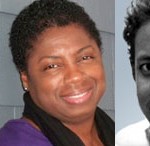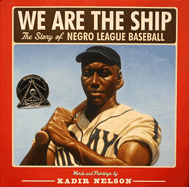 The reason I write about sports, women's history, and women's sports history, is that I grew up loving sports. I graduated from high school the week before Title IX was passed, so I didn't have opportunities to play in school, like girls do today. I played at camp, on the street, and with my father and my brother.
The reason I write about sports, women's history, and women's sports history, is that I grew up loving sports. I graduated from high school the week before Title IX was passed, so I didn't have opportunities to play in school, like girls do today. I played at camp, on the street, and with my father and my brother.
Sue Macy on Playing Ball with Passion
 The reason I write about sports, women's history, and women's sports history, is that I grew up loving sports. I graduated from high school the week before Title IX was passed, so I didn't have opportunities to play in school, like girls do today. I played at camp, on the street, and with my father and my brother.
The reason I write about sports, women's history, and women's sports history, is that I grew up loving sports. I graduated from high school the week before Title IX was passed, so I didn't have opportunities to play in school, like girls do today. I played at camp, on the street, and with my father and my brother.

 When I’m working on a book, there’s a perfectly balanced moment when anything seems possible. It comes as I’m well into the research, bursting with ideas and dreams and enthusiasm. Once I start writing, it’s not long before I crash. Reality sets in fast: not everything that fascinates me is going to fit between the covers of a book.
When I’m working on a book, there’s a perfectly balanced moment when anything seems possible. It comes as I’m well into the research, bursting with ideas and dreams and enthusiasm. Once I start writing, it’s not long before I crash. Reality sets in fast: not everything that fascinates me is going to fit between the covers of a book. High school offers numerous opportunities to integrate multimedia into literacy activities across content areas. In this month’s column, please find a sampling of ready-to-use materials that will enrich and stimulate conversations about books, support student research, and enable students and teachers to hear from writers and illustrators about their craft.
High school offers numerous opportunities to integrate multimedia into literacy activities across content areas. In this month’s column, please find a sampling of ready-to-use materials that will enrich and stimulate conversations about books, support student research, and enable students and teachers to hear from writers and illustrators about their craft. Everyone in education has heard about different learning styles; some of the most prominent are visual, auditory, and kinesthetic. Perhaps educators have even considered their own learning style and how it influences teaching. But, has consideration ever been given to how these learning styles impact inspiration, interest, and research for a project that follows the inquiry process?
Everyone in education has heard about different learning styles; some of the most prominent are visual, auditory, and kinesthetic. Perhaps educators have even considered their own learning style and how it influences teaching. But, has consideration ever been given to how these learning styles impact inspiration, interest, and research for a project that follows the inquiry process?
 Forty years ago, two librarians and a publisher at the American Library Association conference lamented that no African-American author or illustrator had yet been honored with a Newbery or Caldecott medal. In response to that conversation, they decided to establish an award that would acknowledge the achievements of African-American writers and artists in the field of children’s literature.
Forty years ago, two librarians and a publisher at the American Library Association conference lamented that no African-American author or illustrator had yet been honored with a Newbery or Caldecott medal. In response to that conversation, they decided to establish an award that would acknowledge the achievements of African-American writers and artists in the field of children’s literature. Walter Wick set up a complex device to snap a picture of a single drop of it. Barbara Kerley’s crystal-clear color photographs reveal how people worldwide are dependent on it, and connected by it. Langston Hughes, Karen Hesse, Jon Muth, and Herbert Shoveller celebrate its arrival in different forms. Water: ubiquitous, yet often scarce, and endlessly fascinating.
Walter Wick set up a complex device to snap a picture of a single drop of it. Barbara Kerley’s crystal-clear color photographs reveal how people worldwide are dependent on it, and connected by it. Langston Hughes, Karen Hesse, Jon Muth, and Herbert Shoveller celebrate its arrival in different forms. Water: ubiquitous, yet often scarce, and endlessly fascinating. Fall is in the air, which, after a hot Santa Fe summer, feels welcome. I've planted a few pansies and am slowly moving some potted plants inside into what I call my winter garden. When the cold northern New Mexico winter arrives, the clerestory windows above our entry atrium will bring welcome sun to my plants—and me. Along with mulling over which green companions to nurture during the coming months, I'm thinking about what writing projects to begin.
Fall is in the air, which, after a hot Santa Fe summer, feels welcome. I've planted a few pansies and am slowly moving some potted plants inside into what I call my winter garden. When the cold northern New Mexico winter arrives, the clerestory windows above our entry atrium will bring welcome sun to my plants—and me. Along with mulling over which green companions to nurture during the coming months, I'm thinking about what writing projects to begin. As goals of information literacy have been expanded to include skills and attitudes that ultimately allow students to construct their own knowledge based on deep learning of interest to them, all of us can gain insight from professional authors who naturally incorporate those inquiry skills and attitudes into their own writing process.
As goals of information literacy have been expanded to include skills and attitudes that ultimately allow students to construct their own knowledge based on deep learning of interest to them, all of us can gain insight from professional authors who naturally incorporate those inquiry skills and attitudes into their own writing process.
 This post offers a sampling of TeachingBooks.net's recordings of favorite children's and young adult authors sharing insights about their work. In these brief audio excerpts students will hear authors express their enthusiasm for their subjects as they reveal how their passions have guided their research and writing.
This post offers a sampling of TeachingBooks.net's recordings of favorite children's and young adult authors sharing insights about their work. In these brief audio excerpts students will hear authors express their enthusiasm for their subjects as they reveal how their passions have guided their research and writing. We're starting school. First day. My sister and me: we are eight and five; second grade and kindergarten.
We're starting school. First day. My sister and me: we are eight and five; second grade and kindergarten.

 Welcome to this new monthly post that reveals approaches to professional writing and research in the words of extraordinary authors and illustrators of books for children and teens.
Welcome to this new monthly post that reveals approaches to professional writing and research in the words of extraordinary authors and illustrators of books for children and teens.